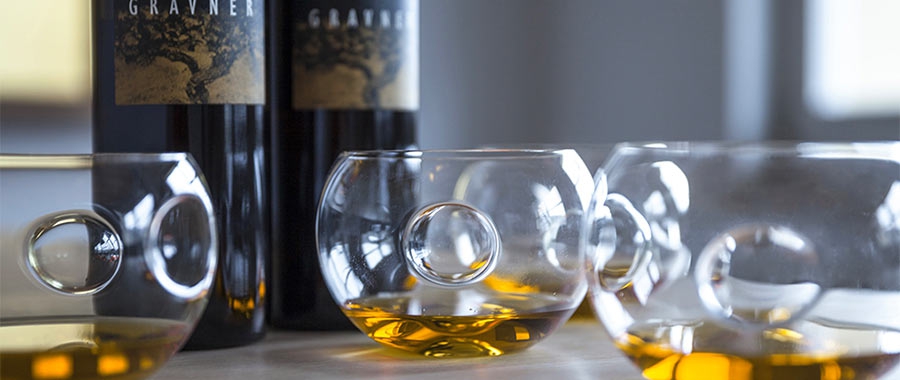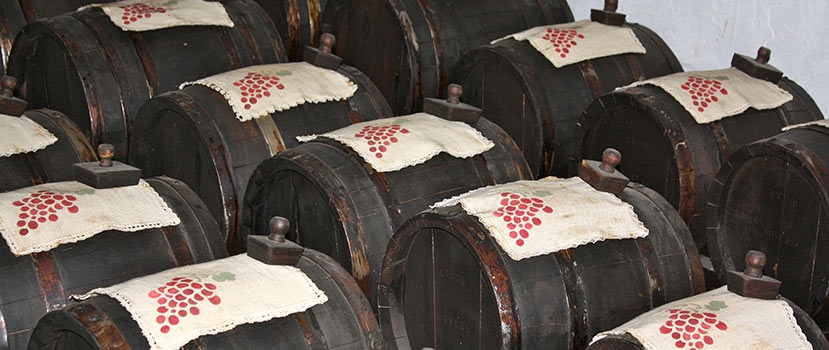BLOG
Savoring Excellence: Exploring Italy's Top Wine Estates through the 2004 Vintage with Istituto Grandi Marchi
Victoria Daskal
Tasting & Trends
On June 25th, London played host to a prestigious gathering of Italy's top wine producers, unveiling their flagship wines to the UK trade and press.
This exclusive horizontal tasting of the 2004 vintage marked the 20th anniversary of the Istituto Grandi Marchi, a consortium representing Italy's most esteemed family-owned estates. Membership criteria requires the estates to be under family ownership, with a minimum of 25 years in operation (though often they are spanning centuries), deep regional roots, and unwavering commitments to sustainability and premium quality.

Patrick Schmitt MW, editor of The Drinks Business, led the masterclass, providing context for each producer and posing a pivotal question: "Do these fine wines improve with time in bottle?"
The 2004 vintage showed diverse outcomes across Italy, shaped by regional nuances and grape varietals. Following the disastrous 2002 and scorching 2003, 2004 emerged as a notably cooler year. Though the quality it brought was debatable- for instance in Tuscany, it provided "welcome freshness in Chianti Classico," according to Albiera Antinori, reflecting positively on Sangiovese. Conversely, at La Cantina Di Nozzole just minutes away, it was deemed "not a good year for Cabernet Sauvignon."
Tasting notes follow in presentation order:
- Carpenè Malvolti, 1924 Prosecco, Conegliano Valdobbiadene Prosecco Brut Superiore DOCG NV Veneto(Traditionally produced as a non-vintage thus no 2004 was available for this event)
A special cuvée dedicated to founder Antonio Carpenè, credited with pioneering the study and experimentation of the Prosecco sparkling wine. A historical blend of 90% Glera, and 10% ancient varieties from the site including Bianchetta, Verdiso and Perera. Sensational aromas of succulent pear and fresh lemon with layers of blossom and hay. Soft delicate mousse and balanced crisp acidity with 8g/L residual sugar.
- Ca’ del Bosco, Annamaria Clementi 2008 Franciacorta Riserva DOCG, Lombardy(No 2004 vintage left)
Blend of hand-picked 55% Chardonnay, 25% Pinot Blanc and 20% Pinot Noir which they famously wash and dry prior to gentle pressing. Powerful nose of roasted hazelnuts, cream brioche, and poached pear. Incredible finesse on the palate with an expansive fruit concentration then a long, savoury finish. Zero dosage.
- Jermann, Vintage Tunina 2022 Venezia Giulia IGT, Friuli-Venezia Giulia (Current vintage served)
A single vineyard field blend of five varieties: Sauvignon Blanc, Chardonnay, Ribolla Gialla, Malvasia Istriana, and Picolit. Aromatic pine, juniper, and jasmine leap out, leading to a remarkably layered and textured palate with fresh, creamy mouthfeel and a long finish.
- Umani Ronchi, Plenio 2004 Verdicchio dei Castelli di Jesi DOC Classico Riserva, Marche
Vivid gold in the glass with a complex nose of toasted pine nuts, dried hay, ripe yellow peaches and honey. Reminiscent of old Hunter Semillion. The palate is energetic with a bright acidity and harmonious savoury and mineral conclusion. Still evolving beautifully, it's in fantastic shape and best enjoyed with equally fine cuisine.
- Marchesi Antinori, Badia a Passignano 2004 Chianti Classico Riserva DOCG, Tuscany
Presented by Albiera Antinori, this is a 100% Sangiovese matured in Hungarian Oak which she revealed has been especially ‘softer on their Sangiovese,’ than French oak. Mid garnet appearance with deep aromas of dried cherries and cranberries, warm thyme and leather. She called this a “fresh vintage, following the hot 2003 that is showing especially well now”. Indeed, the mouthfeel is perfectly polished with smooth, yet structured tannins, distinct pure damson and cherry fruit persists. Still developing beautifully.
- La Cantina Di Nozzole, Ambrogio e Giovanni Folonari Tenute, Il Pareto 2004, Toscana Rosso IGT, Tuscany
An entirely different proposition from Tuscany: 100% Cabernet Sauvignon which proved the point that this widely planted Bordeaux grape can take on a truly Italian personality here. Deep garnet appearance with rich and powerful notes of blackberries, cassis, cedar and spice. A powerful supercharged palate, in proportion to its gripping tannins, concentrated ripe fruit and full body feel.
- Col d’Orcia, Poggio al Vento 2004 Brunello di Montalcino Riserva DOCG, Tuscany
A pure Sangiovese, locally known as ‘Brunello,’ planted in the 1970s by Marone Cinzano in very sandy soil. This vineyard, the largest certified organic vineyard in Tuscany is located in the hilltop village of Montalcino, where relentless winds inspired the name of their flagship wine: Poggio al Vento. It offers potent aromas of cedar and ripe black fruit, with a powerful, tannic, and full-bodied palate. Bright, balanced acidity shines through savoury layers of prune and saddle leather, giving a distinctive personality to this sleek Brunello.
- Tenuta San Guido, Sassicaia 2004 Bolgheri Sassicaia DOC, Tuscany
The only wine from a single wine estate in Italy to have its own DOC. Extraordinary aromas plunging into wild bramble, plums, tapenade and dried lavender. A superbly sleek and complex palate layered with drying cherries, tobacco, earth and dried herbs. Elegant tannins with a long finish.
- Tenuta San Leonardo, San Leonardo 2004 Vigneti delle Dolomiti IGT, Trentino
Considered by some to be the Sassicaia of the north for their success with Bordeaux varietals in the Dolomitic Alps. Indeed, the connection runs deep as the father, Carlo Guerrieri Gonzaga once worked in Tuscany with Mario Incisa della Rocchetta, the creator of Sassicaia. The San Leonardo is a blend of 60% Cabernet Sauvignon, 30% Carmenère, 10% Merlot aged in new and used French oak. Intense notes of violet, vetiver, cloves and blackberries. Sumptuous glossy tannins, and long unfurling finish.

- Michele Chiarlo, Barolo Cerequio DOCG 2004 Piemonte
Alberto Chiarlo presented this wine explaining that Cerequio, one of the top single vineyard sites in La Morra, has four times the magnesium content than any other soil in the region. While La Morra’s reputation is to be softer, these wines are especially structured and aromatic. “We’re traditional,” continues Chiarlo, outlining his customary 20 days skin-contact regime after fermentation in 55hl oak vats. Ripe and intense bouquet of black cherry, violet, tobacco and toast. Ample grippy tannins, lively acidity and with layers of tertiary and red juicy cherry on the palate.
- Pio Cesare, Barolo 2004 Barolo DOCG, Piemonte
Augusto Boffa continues the Barolo discussion, concurring that 2004 is a much loved and classic vintage in Barolo and that Pio Cesare is also a proud “traditionalist” of the region. The wine he presents is a blend of the family’s own vineyards across Serralunga d’Alba, Grinzane Cavour, La Morra and Novello fermented in steel vats followed by 25-30 day skin maceration. The results are a powerful and harmonious presentation of vivid cranberries, cherries, earth, cedar and leather. Magnificent tannins with refined texture and long lingering finish of pure fruit, fresh acidity and savoury tobacco notes.
- Mastroberardino, Radici 2004 Taurasi Riserva DOCG, Campania
If Aglianico is considered the Nebbiolo of southern Italy, then Mastroberardino has played a significant role in that. The 10th generation wine family first produced its super premium Radici wine in 1986 following extensive research in the ideal terroir for Aglianico. The wine is magnetic with a dominant aroma of black fruit, lavender, smoke and charcuterie. Equally tremendous palate with firm tannins completely in tandem with incredible fruit concentration.
- Lungarotti, Rubesco Vigna Monticchio 2004 Torgiano Rosso Riserva DOCG, Umbria
A blend of 70% Sangiovese and 30% Canaiolo grown hillside at the confluence of Tiber and Chiascio rivers which provides a variety of soils: layers of clay, sand and limestone. There is an old-world sensation to this wine, wafts of incense, damp earth, balsam, dried strawberries and cedar. Slightly rustic on the palate calling out for a hearty meal.
- Argiolas, Turriga 2004, Isola dei Nuraghi IGT, Sardinia
Blend of 85% Cannonau, 5% Bovale, 5% Carignano, 5% Malvasia Nera grown 300m above sea level in the central south of the island on mainly limestone soils with constant winds that maintains acidity in the grapes. An inviting bouquet of Mediterranean herbs, stewed cherries and strawberries grounded by an earthy spice. The palate is both vivacious and velvety, rounded and ripe with a distinct structure and a haunting exotic finish.
- Donnafugata, Mille e una notte 2004, Contessa Entellina DOC, Sicily
First created in 1995 with the help of Giacomo Tachis and nicknamed a “Super Sicilian” for its combination of native Nero d’Avola and small percentages of French varietals Syrah and Petit Verdot, followed by 16 months ageing in new and used French barrels. Spicy, juicy, full of personality yet a serious wine that shows mature notes of leather,
prunes, vetiver and toast. Superbly balanced between full body feel and concentrated sweet fruit, steadied by integrating glossy tannins promising more development to come.
- Tasca d’Almerita, Rosso del Conte 2004 Contea di Sclafani DOC, Sicily
Alberto Tasca, who is also president of Sicily’s SOStain Sicilia programme, presented his Rosso del Conte, a field blend of bush trained Nero d’Avola and Perricone that grows 480m above sea level. A standout in the flight with its exuberant energy, bright acidity, dynamic and pure red fruit palate. Sophisticated, complex, and energetic all the same, a beautifully authentic wine.
- Rivera, Puer Apuliae 2004 Castel del Monte Nero di Troia DOC, Puglia
Puer Apuliae, or “Son of Puglia,” was the nickname of Frederick II of Swabia, the 13th-century Emperor of the Holy Roman Empire, who cherished this region and built the Castel del Monte, now the name of the DOC. Rivera’s top wine, named in homage, is crafted from the indigenous Nero di Troia variety. Interestingly, this wine comes from vines that were just five years old at the time. It has a deep, inky appearance with concentrated dark fruit and meaty aromas. The palate offers blackberry fruit and smooth tannins, with a long finish that unfurls notes of cloves, earth, and balsamic.
- Masi, Costasera 2004 Amarone della Valpolicella Classico Riserva DOC, Veneto
CEO and president of Masi, Sandro Boscaini, did not seem to mind bringing up the end of the 18-family wine tasting, smiling as he stood to present the “sleeping giant” that he calls his Amarone. Masi has also recently celebrated the 250th harvest (1772-2022) of the Boscaini family, so they are accustomed to waiting. Costasera Amarone is a blend of 70% Corvina, 15% Rondinella, 10% Oseleta, 5% Molinara which is grown on the hillside vineyards that face the “sera” or the sunset, and thus benefit from the extra reflected light and mild climate of Lake Garda. Following an extra-long appassimento process lasting more than 120 days the wine is aged for 38-40 months in 600-litre Slavonian and Allier oak casks. A most suitable wine for the grand finale of this superlative tasting. Incredibly intense aromas swirling out of crushed violets, baked cherries and plums, earthy tones with spice and dried herbs. An enormous wine with a crescendo of flavours ranging from sweet red and black fruit, bay leaves and thyme, cinnamon, cedar and leather on the finish. The 16% alcohol is minor in comparison to the big flavours and gripping fine tannins. Bravo.

The extraordinary tasting concluded with loud applause and cheers from guests who had been taken on a cross-country journey through the lens of the notable 2004 vintage. The presence and insights of each presenter went beyond the wines, providing rich context to their histories, hardships, triumphs, and most importantly, their unique identities within the Italian wine scene.



